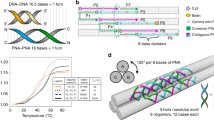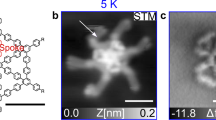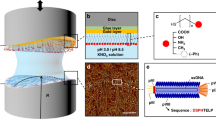Abstract
Organic polymers are generally regarded as thermal insulators because of their random arrangement of polymeric chains that lead to scattering of heat-conducting phonons. We previously found that highly oriented assemblies composed of M13 phage, a filamentous virus, showed high thermal diffusivity, even though phonons are conducted on noncovalent bonds. However, biomolecular M13 phages did not allow utilization of organic solvents, resulting in limited applicability. Here, we utilized chemically modified M13 phage with oligo(ethylene glycol) (OEG) to improve its solubility and resistance to organic solvents, and to expand the applicability of phage-based thermally conductive assemblies. The high thermal diffusivity of assemblies composed of M13 phages modified with longer EG chains (EG unit: 10) was maintained when the assemblies were prepared using a mixed solvent of water and tetrahydrofuran, whereas that of assemblies composed of unmodified and shorter EG chain (3 and 6)-modified M13 phages was not maintained. When the mixed solvent was used, structural characterization revealed the presence of ordered and hexagonally packed structures that formed ordered assemblies, leading to phonon-conductive assemblies in the case of the longer EG chain-modified M13 phages. Our results will contribute to the construction of novel thermally conductive soft materials composed of biomacromolecular assemblies using organic solvents on substrates with complex surface morphologies and/or hydrophobic surfaces.
This is a preview of subscription content, access via your institution
Access options
Subscribe to this journal
Receive 12 print issues and online access
$259.00 per year
only $21.58 per issue
Buy this article
- Purchase on Springer Link
- Instant access to full article PDF
Prices may be subject to local taxes which are calculated during checkout






Similar content being viewed by others
References
Dogic Z, Fraden S. Ordered phases of filamentous viruses. Curr Opin Colloid Interface Sci. 2006;11:47–55.
Dogic Z, Sharma P, Zakhary MJ. Hypercomplex liquid crystals. Annu Rev Condens Matter Phys. 2014;5:137–57.
Zhang Z, Grelet E. Tuning chirality in the self-assembly of rod-like viruses by chemical surface modifications. Soft Matter. 2012;9:1015–24.
Zan T, Wu F, Pei X, Jia S, Zhang R, Wu S, et al. Into the polymer brush regime through the “grafting-to” method: Densely polymer-grafted rodlike viruses with an unusual nematic liquid crystal behavior. Soft Matter. 2015;12:798–805.
Smith GP, Petrenko VA. Phage display. Chem Rev. 1997;97:391–410.
Kehoe J, Kay B. Filamentous phage display in the new millennium. Chem Rev. 2005;105:4056–72.
Sarikaya M, Tamerler C, Jen A, Schulten K, Baneyx F. Molecular biomimetics: nanotechnology through biology. Nat Mater. 2003;2:577–85.
Shiba K. Exploitation of peptide motif sequences and their use in nanobiotechnology. Curr Opin Biotechnol. 2010;21:412–25.
Sawada T, Mihara H, Serizawa T. Peptides as new smart bionanomaterials: molecular recognition and self-assembly capabilities. Chem Rec. 2013;13:172–86.
Günay K, Klok H-A. Identification of soft matter binding peptide ligands using phage display. Bioconjugate Chem. 2015;26:2002–15.
Lee S-W, Wood BM, Belcher AM. Chiral smectic C structures of virus-based films. Langmuir. 2003;19:1592–8.
Merzlyak A, Indrakanti S, Lee S-W. Genetically engineered nanofiber-like viruses for tissue regenerating materials. Nano Lett. 2009;9:846–52.
Chung W-J, Merzlyak A, Yoo S, Lee S-W. Genetically engineered liquid-crystalline viral films for directing neural cell growth. Langmuir. 2010;26:9885–90.
Wu L, Lee AL, Niu Z, Ghoshroy S, Wang Q. Visualizing cell extracellular matrix (ECM) deposited by cells cultured on aligned bacteriophage M13 thin films. Langmuir. 2011;27:9490–6.
Yang S, Chung W-J, McFarland S, Lee S-W. Assembly of bacteriophage into functional materials. Chem Rec. 2013;13:43–59.
Moghimian P, Srot V, Rothenstein D, Facey SJ, Harnau L, Hauer B, et al. Adsorption and self-assembly of m13 phage into directionally organized structures on c and SiO2 films. Langmuir. 2014;30:11428–32.
Oh J-W, Chung W-J, Heo K, Jin H-E, Lee BY, Wang E, et al. Biomimetic virus-based colourimetric sensors. Nat Commun. 2014;5:3043.
Courchesne N-MM, Klug MT, Chen P-YY, Kooi SE, Yun DS, Hong N, et al. Assembly of a bacteriophage-based template for the organization of materials into nanoporous networks. Adv Mater. 2014;26:3398–404.
Bardhan NM, Ghosh D, Belcher AM. Carbon nanotubes as in vivo bacterial probes. Nat Commun. 2014;5:4918.
Lee J, Jin H-E, Desai MS, Ren S, Kim S, Lee S-W. Biomimetic sensor design. Nanoscale. 2015;7:18379–91.
Sawada T. Filamentous virus-based soft materials based on controlled assembly through liquid crystalline formation. Polym J. 2017;49:639–47.
Sawada T, Serizawa T. Filamentous viruses as building blocks for hierarchical self-assembly toward functional soft materials. Bull Chem Soc Jpn. 2018;91:455–66.
Zhi X, Zheng C, Xiong J, Li J, Zhao C, Shi L, et al. Nanofilamentous virus-based dynamic hydrogels with tunable internal structures, injectability, self-healing, and sugar responsiveness at physiological ph. Langmuir. 2018;34:12914–23.
Mohan K, Weiss GA. Chemically modifying viruses for diverse applications. ACS Chem Biol. 2016;11:1167–79.
Liu S, Zan T, Chen S, Pei X, Li H, Zhang Z. Thermoresponsive chiral to nonchiral ordering transformation in the nematic liquid-crystal phase of rodlike viruses: turning the survival strategy of a virus into valuable material properties. Langmuir. 2015;31:6995–7005.
Cao J, Liu S, Xiong J, Chen Y, Zhang Z. Stimuli responsive chiral liquid crystal phases of phenylboronic acid functionalized rodlike viruses and their interaction with biologically important diols. Chem Commun. 2014;50:10402–5.
Zhang Z, Krishna N, Lettinga PM, Vermant J, Grelet E. Reversible gelation of rod-like viruses grafted with thermoresponsive polymers. Langmuir. 2009;25:2437–42.
Peplow M. The plastics revolution: How chemists are pushing polymers to new limits. Nature. 2016;536:266–8.
Shen S, Henry A, Tong J, Zheng R, Chen G. Polyethylene nanofibres with very high thermal conductivities. Nat Nanotechnol. 2010;5:251–5.
Wang X, Ho V, Segalman RA, Cahill DG. Thermal conductivity of high-modulus polymer fibers. Macromolecules. 2013;46:4937–43.
Wang Z, Carter JA, Lagutchev A, Koh YK, Seong N-HH, Cahill DG, et al. Ultrafast flash thermal conductance of molecular chains. Science. 2007;317:787–90.
Chae HG, Kumar S. Materials science. Making strong fibers. Science. 2008;319:908–9.
Kim G-H, Lee D, Shanker A, Shao L, Kwon M, Gidley D, et al. High thermal conductivity in amorphous polymer blends by engineered interchain interactions. Nat Mater. 2015;14:295–300.
Singh V, Bougher TL, Weathers A, Cai Y, Bi K, Pettes MT, et al. High thermal conductivity of chain-oriented amorphous polythiophene. Nat Nanotechnol. 2014;9:384–90.
Shoji Y, Ishige R, Higashihara T, Morikawa J, Hashimoto T, Takahara A, et al. Cross-linked liquid crystalline polyimides with siloxane units: their morphology and thermal diffusivity. Macromolecules. 2013;46:747–55.
Wang RY, Segalman RA, Majumdar A. Room temperature thermal conductance of alkanedithiol self-assembled monolayers. Appl Phys Lett. 2006;89:173113.
Huang X, Liu G, Wang X. New secrets of spider silk: exceptionally high thermal conductivity and its abnormal change under stretching. Adv Mater. 2012;24:1482–6.
Sawada T, Murata Y, Marubayashi H, Nojima S, Morikawa J, Serizawa T. Filamentous virus-based assembly: Their oriented structures and thermal diffusivity. Sci Rep. 2018;8:5412.
Sawada T, Murata Y, Marubayashi H, Nojima S, Morikawa J, Serizawa T. High thermal diffusivity in thermally treated filamentous virus-based assemblies with a smectic liquid crystalline orientation. Viruses. 2018;10:608.
Sawada T, Okeya Y, Hashizume M, Serizawa T. Screening of peptides recognizing simple polycyclic aromatic hydrocarbons. Chem Commun. 2013;49:5088–90.
Sawada T, Asada M, Serizawa T. Selective rare earth recovery employing filamentous viruses with chemically conjugated peptides. ChemistrySelect. 2016;1:2712–6.
Suzuki S, Sawada T, Ishizone T, Serizawa T. Affinity-based thermoresponsive precipitation of proteins modified with polymer-binding peptides. Chem Commun. 2016;52:5670–3.
Morikawa J, Hashimoto T. Thermal diffusivity of aromatic polyimide thin films by temperature wave analysis. J Appl Phys. 2009;105:113506.
Marubayashi H, Asai S, Sumita M. Complex crystal formation of poly(l-lactide) with solvent molecules. Macromolecules. 2012;45:1384–97.
Nam Y, Shin T, Park H, Magyar AP, Choi K, Fantner G, et al. Virus-templated assembly of porphyrins into light-harvesting nanoantennae. J Am Chem Soc. 2010;132:1462–3.
Acknowledgements
This work was supported by the Japan Science and Technology Agency (JST) through the Precursory Research for Embryonic Science and Technology (PRESTO) Grant Number JPMJPR17I4 to TS. TS is grateful to the Challenging Research Award from the Tokyo Institute of Technology. The SAXS measurements were performed under the approval of the Photon Factory Advisory Committee (Nos. 2017G084, 2018G655, and 2019G112).
Author information
Authors and Affiliations
Corresponding authors
Ethics declarations
Conflict of interest
The authors declare that they have no conflict of interest.
Additional information
Publisher’s note Springer Nature remains neutral with regard to jurisdictional claims in published maps and institutional affiliations.
Supplementary information
Rights and permissions
About this article
Cite this article
Sawada, T., Tsuruoka, T., Ueda, N. et al. Thermally conductive molecular assembly composed of an oligo(ethylene glycol)-modified filamentous virus with improved solubility and resistance to organic solvents. Polym J 52, 803–811 (2020). https://doi.org/10.1038/s41428-020-0328-7
Received:
Revised:
Accepted:
Published:
Issue Date:
DOI: https://doi.org/10.1038/s41428-020-0328-7



